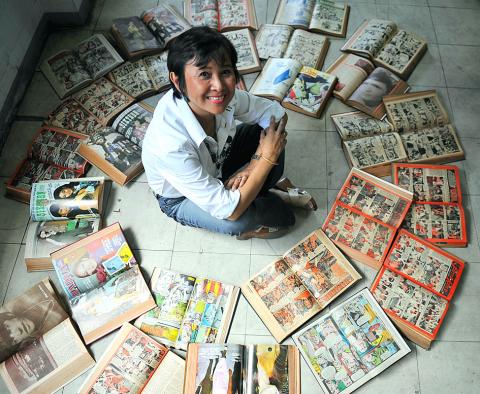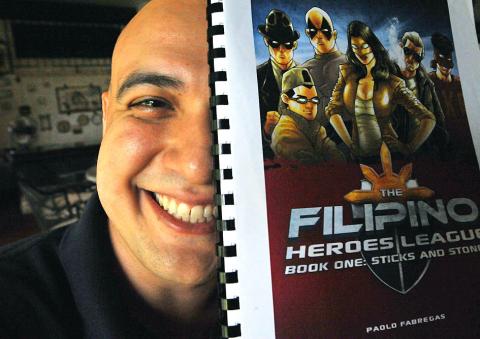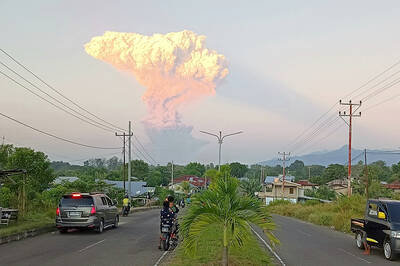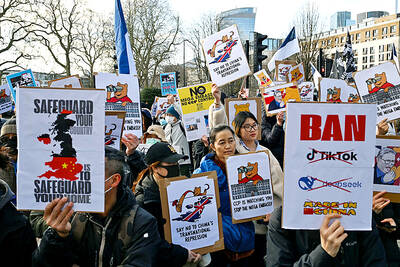Philippine comic books have nurtured talent for international TV and animation blockbusters, but the once-mighty industry is fighting to survive as it comes up against the Internet and other new media.
Comic books that dominated the Philippine publishing industry just a couple of decades ago are now largely relegated to photocopied titles sold in a few specialty stores and at conventions, veteran artist Rico Rival said.
“There are still a lot of good Filipino artists. They just don’t have an outlet anymore. They just photocopy their own works,” said Rival who has worked for local publications as well as US comic and animation companies.

PHOTO: AFP
The 72-year-old Rival is now retired, but still indulges his passion by drawing occasionally for Philippine magazines and doing commissioned art at conventions.
Local comic books, popularly known as komiks were once the most widely read periodicals in the country, with dozens of titles sold on newsstands every day. Terry Bagalso, editor of Atlas Publishing, once the country’s largest komiks publisher, recalled that in the 1980s, at the height of the industry’s popularity, his company was printing 30 titles a week.
Its top-selling titles easily sold 400,000 copies a week with total komiks circulation in the millions.

PHOTO: AFP
“We had to send out an armored car to collect our sales earnings,” she said.
These komiks — printed in black and white on cheap newsprint — presented serialized stories in a wide variety of genres, including romance, horror, super-heroes, historical adventure, fantasy, comedy and fairytales.
Sold largely by street vendors, they appealed mainly to the poor masses and cost just a few centavos (less than US$0.01), far cheaper than a movie ticket or other forms of popular entertainment.
Komiks characters such as superheroine Darna, the mermaid Dyesebel and the monster--slaying “Panday” (the Blacksmith) are still household words in the Philippines and live on in TV series and movies.
The artists who worked on these komiks caught the attention of US companies such as Marvel and DC Comics, which started recruiting them in the 1970s to work on characters including Batman and Conan the Barbarian.
“They were amazed that Filipinos were very good illustrators. They thought there was an art school that trained us and then they came here and they found that we just influenced each other,” Rival said.
Many Filipino artists then went on to produce cartoons for companies such as Disney, Nickelodeon and Cartoon Network. Today, Filipino artists can be found working on big-screen animation projects such as the Toy Story series.
However, despite that success, komiks have virtually disappeared from Philippine newsstands.
The consensus is that komiks lost their audience as Filipinos turned to more modern forms of entertainment, such as TV, videogames, DVDs and the Internet.
“It is the technology. With one click on the computer, you can get anything. So instead of -reading komiks, people like computers, cellphones and other things,” Bagalso said.
There have been various attempts to revive komiks in recent years, but none have had much success.
Alexie Cruz, editor of PSICOM, a local publisher, said his company’s last komiks foray two years ago — a comedy title called Topak (Nutty) — fell victim to poor sales after just two issues.
“One of the main problems is the bookstores don’t cater to komiks by Filipino publishers. They give them very little space,” he said.
Ironically, PSICOM’s big sellers are magazines of manga, or Japanese comics, as well as licensed reprints of DC Comics titles — which do get shelf-space in local bookstores, Cruz said.
However, local creators won’t give up. Some publishers still come out with their own home-grown “graphic novels” — extended stories told in comic format.
Philippine publisher Visprint is producing one such effort next year: Filipino Heroes League, a semi--comedic tale by artist-writer Paolo Fabregas who puts superheroes into a developing world setting.
“They’re underfunded, unappreciated and generally unwanted ... like Kid Kidlat [Kid Lightning]. He’s super-fast and super-poor,” Fabregas, 32, said with a laugh.
Like many other aspiring Filipino komiks artists, Fabregas started out either putting his stories on the Internet or selling home-made copies.
His main job is in advertising and he describes his komiks work as “a glorified hobby.”
Komiks artist Gener Pedrina said he and other creators just drew the stories, printed them with a photocopier, stapled them by hand and then sold them on their own.
He described his products as “labors of love,” because they take so much time, but make barely enough to break even.
Pedrina’s superhero title, Sanduguan, (Blood Brothers) and other komiks like Zombies in Manila and Gerilya (Guerrilla) komiks, are sold at the handful of comic conventions held in the Philippines each year.
While these titles may not have the polish of their predecessors, Rival said they still kept the tradition alive.
“Komiks is still here. It won’t go away. There may not be publications, but artists can come up with their own komiks. You cannot restrain their creativity,” he said.

BOMBARDMENT: Moscow sent more than 440 drones and 32 missiles, Volodymyr Zelenskiy said, in ‘one of the most terrifying strikes’ on the capital in recent months A nighttime Russian missile and drone bombardment of Ukraine killed at least 15 people and injured 116 while they slept in their homes, local officials said yesterday, with the main barrage centering on the capital, Kyiv. Kyiv City Military Administration head Tymur Tkachenko said 14 people were killed and 99 were injured as explosions echoed across the city for hours during the night. The bombardment demolished a nine-story residential building, destroying dozens of apartments. Emergency workers were at the scene to rescue people from under the rubble. Russia flung more than 440 drones and 32 missiles at Ukraine, Ukrainian President Volodymyr Zelenskiy

‘SHORTSIGHTED’: Using aid as leverage is punitive, would not be regarded well among Pacific Island nations and would further open the door for China, an academic said New Zealand has suspended millions of dollars in budget funding to the Cook Islands, it said yesterday, as the relationship between the two constitutionally linked countries continues to deteriorate amid the island group’s deepening ties with China. A spokesperson for New Zealand Minister of Foreign Affairs Winston Peters said in a statement that New Zealand early this month decided to suspend payment of NZ$18.2 million (US$11 million) in core sector support funding for this year and next year as it “relies on a high trust bilateral relationship.” New Zealand and Australia have become increasingly cautious about China’s growing presence in the Pacific

Indonesia’s Mount Lewotobi Laki-Laki yesterday erupted again with giant ash and smoke plumes after forcing evacuations of villages and flight cancelations, including to and from the resort island of Bali. Several eruptions sent ash up to 5km into the sky on Tuesday evening to yesterday afternoon. An eruption on Tuesday afternoon sent thick, gray clouds 10km into the sky that expanded into a mushroom-shaped ash cloud visible as much as 150km kilometers away. The eruption alert was raised on Tuesday to the highest level and the danger zone where people are recommended to leave was expanded to 8km from the crater. Officers also

ESPIONAGE: The British government’s decision on the proposed embassy hinges on the security of underground data cables, a former diplomat has said A US intervention over China’s proposed new embassy in London has thrown a potential resolution “up in the air,” campaigners have said, amid concerns over the site’s proximity to a sensitive hub of critical communication cables. The furor over a new “super-embassy” on the edge of London’s financial district was reignited last week when the White House said it was “deeply concerned” over potential Chinese access to “the sensitive communications of one of our closest allies.” The Dutch parliament has also raised concerns about Beijing’s ideal location of Royal Mint Court, on the edge of the City of London, which has so